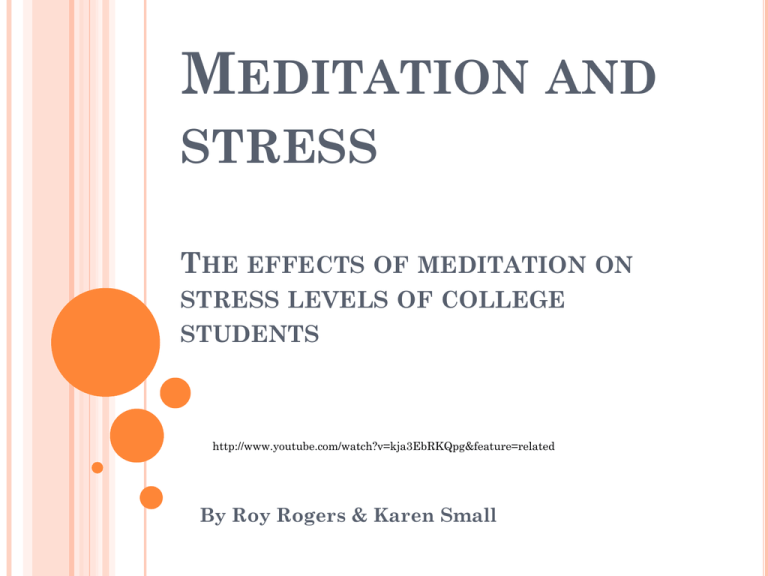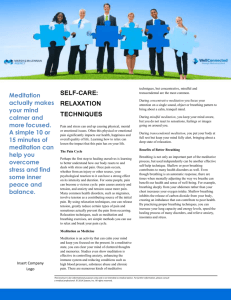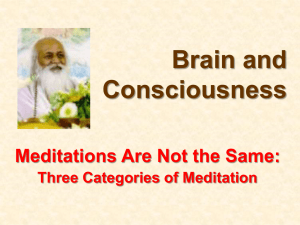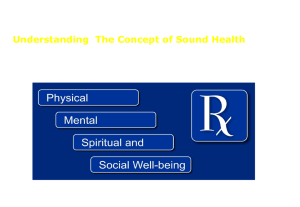1A Meditation and stress
advertisement

MEDITATION AND STRESS THE EFFECTS OF MEDITATION ON STRESS LEVELS OF COLLEGE STUDENTS http://www.youtube.com/watch?v=kja3EbRKQpg&feature=related By Roy Rogers & Karen Small ABSTRACT http://ecoseedemo.com/stock/images/20080222014944_zen%20garden.jpg This experiment examined stress levels in 40 randomly selected Camosun College students, 20 male and 20 female. Both groups met in separate but identical classrooms for one hour twice a week for four weeks leading up to exam period. The experimental group engaged in meditation and deep breathing exercises, while the control group came together to study or socialize. Stress levels were selfreported after the four weeks using the Schmid-Reath Stress Level Indicator. The students that meditated were found to have lower overall stress levels after the four week period than the students in the control group, with a pvalue of 0.025. THEORETICAL CONTEXT According to the American Psychological Association (2009), chronic stress is on the rise in our society. It has been reported that 49% of Americans are living with “extreme stress” and almost half feel that their stress levels have increased in the last 5 years. Chronic stress levels are maladaptive and can lead to fatigue, illness and depression (Walach, Nord, Zier, DietzWaschkowski, Kersig, & Schüpbach, 2007). Research on meditation suggests that it has a powerful ability to calm the mind, increase immune system functioning and restore the body’s nervous system(Hamilton, Kitzman & Guyotte, 2006). Studies have shown that mindful relaxation and meditation on a weekly basis can counteract the negative effects of stress and increase an individual’s ability to cope with future stressors (Capolla & Spectre, 2009). HYPOTHESIS College students who meditate (sit quietly and engage in deep breathing) for one hour twice a week for the month leading up to exam period will experience a decrease in stress levels as compared to the control group. http://bluemooncandles.files.wordpress.com/2009/03/meditation-leaf.jpg INDEPENDENT & DEPENDENT VARIABLES Independent Variable Meditation - defined in this study as sitting quietly and engaging in deep breathing exercises. Dependent Variable Stress levels – measured using the Schmid-Reath Stress Level Indicator http://imagecache5.art.com/p/LRG/26/2619/FMGM D00Z/yellow-gingko-leaves.jpg EXTRANEOUS VARIABLES http://physicalsubculture.com/wpcontent/uploads/2009/ 10/meditation1.jpg Previous meditation experience Cultural background Health status Sleep patterns Nutrition Home life Financial situation PROCEDURE 40 Camosun College students were recruited and randomly assigned into an experimental group and a control group. Both groups met from 8:30 am to 9:30 am in assigned classrooms on campus every Monday and Wednesday morning for four weeks leading up to exams. The two classrooms used were 20’ x 20’ with fresh circulated air, natural lighting and all students were asked to turn off any electrical devices for the entire hour. The experimental group were given yoga mats and were instructed to meditate (sit quietly and engage in deep breathing exercises). The control group were given desks to sit at and were instructed to study or socialize. http://www.tbssct.gc.ca/e val/dev/career/workshops ateliers/pencil.jpg THE SCHMID-REATH STRESS LEVEL INDICATOR At the end of the 4 week period, both groups were asked to rate their stress levels on a scale of 1 to 10 using the SchmidReath Stress Level Indicator. 1 = very calm 10 = very stressed http://upload.wikimedia.org/wikipedia/commons/ thumb/f/fe/Unbalanced_scales.svg/400pxUnbalanced_scales.svg.png RESULTS Experimental Group Control Group N= 20 20 Raw Data: 7.00, 7.00, 7.00, 7.00, 7.00, 7.00, 7.00, 7.00, 7.00, 7.00, 7.00, 7.00, 7.00, 7.00, 7.00, 7.00, 7.00, 7.00, 8.00, 8.00, 7.00, 7.00, 7.00, 7.00, 7.00, 8.00, 8.00, 8.00, 8.00, 8.00, 8.00, 8.00, 8.00, 8.00, 8.00 8.00, 8.00, 8.00, 8.00, 8.00 Mode: 7.00 8.00 Mean: 7.25 7.60 Median: 7.00 8.00 Range: 1 1 SD: 0.444 0.503 T Value: 2.33 P Value: 0.025 DISCUSSION Problems with research: http://hersweetnothings.files.wordpress.com/2 009/08/person-thinking-or-dreaming-gicleeprint-c11860975-jpeg.jpg We did not measure the overall stress levels of the students prior to beginning this study. Had we done so we would have been able to gain a greater insight into how much the experimental group’s stress levels decreased after meditating for 4 weeks. Low Generalizability: The participants in this study were selected from a college campus and thus the results are not representative of the greater population or across different cultures. Bias: Because the groups were selfreporting their stress levels there is a risk of response biases. It must be taken into consideration that some participants may have answered to be seen in a favourable light or to support our hypothesis. DISCUSSION Future Research: The long-term effects of meditation on the health of college students. A 2 year longitudinal study which will include regular selfreport questionnaires, physiological check-ups, EEG scans and interviews. The effects of teaching relaxation techniques to children in elementary school as preparation for later stressors. This study will be aimed at investigating the benefits of early educational programs to foster better coping skills later in life. http://farm3.static.flickr.com/2177/2075361721_fdde367f4 a.jpg DISCUSSION Applications: Raising student awareness of the importance of relaxation techniques to manage stress and promote healthy well-being. Colleges and Universities could increase this awareness through guest speakers, workshops and programs to teach students how to relax and stay healthy while juggling their busy schedules. Educational institutions could also provide quiet areas on campus where students could go throughout the day to meditate and regroup. http://www.mimosaspirit.com/images/Relaxation%20Music%20for%20the%20Healing%20Arts.jpg SUMMARY No matter how busy you feel, there should always be time in every day to relax and take care of yourself. Chronic stress is bad for our health and can lead to fatigue, illness and depression. Meditation is an effective way to live in the moment, improve concentration, relax the body and to give us energy to keep on going during hectic periods of time. http://www.thechristianmeditator.com/meditation%20pic.jpg REFERENCES American Psychological Association. (2009). Stress a major problem in the U.S. APA on-line. Retrieved from: http://www.apa.org/releases/stressproblem.html Coppola, F., & Spector, D. (2009). Natural stress relief meditation as a tool for reducing anxiety and increasing self-actualization. Social Behavior and Personality, 37(3), 307-312. doi:10.2224/sbp.2009.37.3.307 Hamilton, N., Kitzman, H., & Guyotte, S. (2006). Enhancing health and emotion: Mindfulness as a missing link between cognitive therapy and positive psychology. Journal of Cognitive Psychotherapy, 20(2), 123-134. doi:10.1891/jcop.20.2.123. Walach, H., Nord, E., Zier, C., Dietz-Waschkowski, B., Kersig, S., & Schüpbach, H. (2007). Mindfulness-based stress reduction as a method for personnel development: A pilot evaluation. International Journal of Stress Management, 14(2), 188-198. doi:10.1037/1072-5245.14.2.188.









